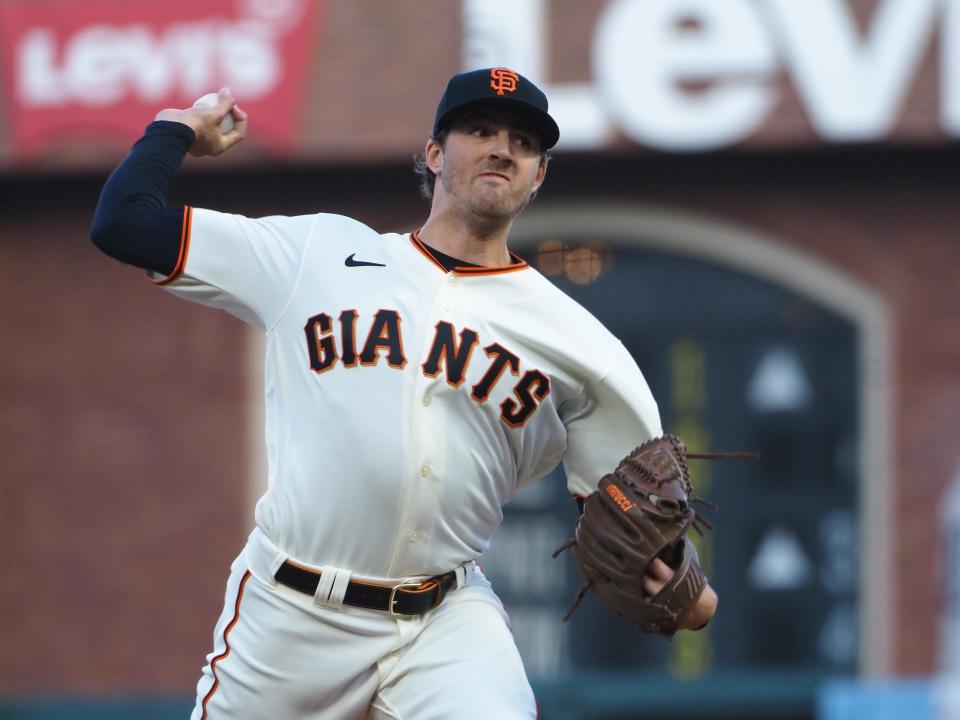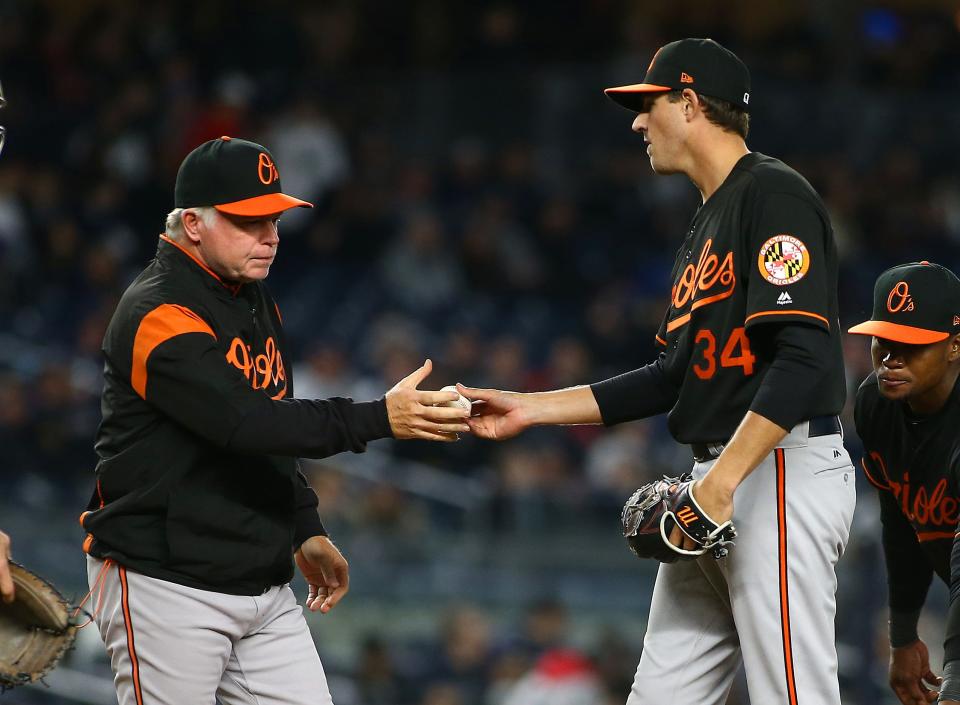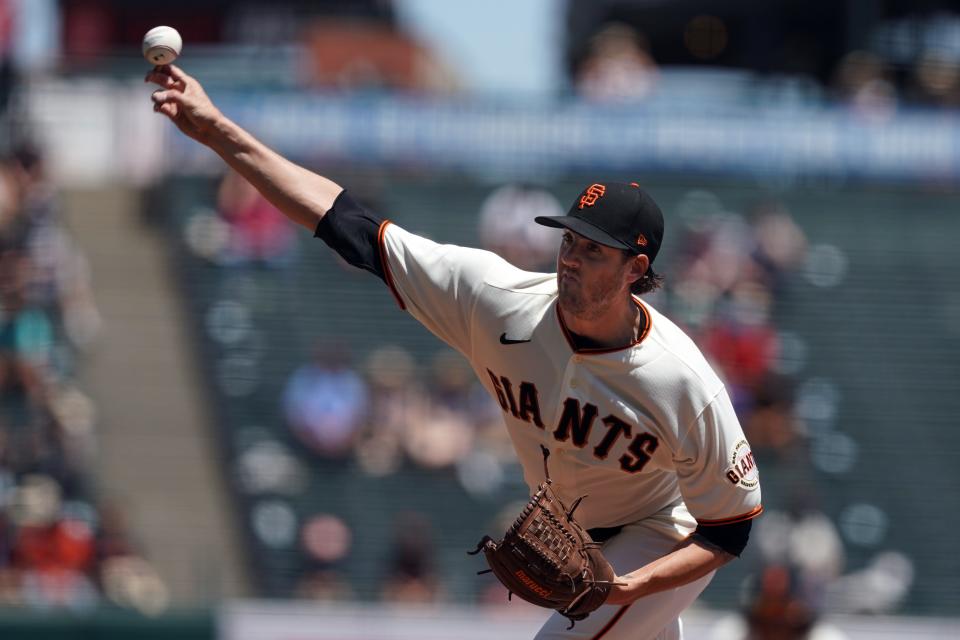A Giant emerges: How Kevin Gausman evolved into the NL's surprise success story
It would be too easy to declare that baseball’s endearing unpredictability is nicely epitomized in the parallel sagas of Kevin Gausman and the San Francisco Giants.
After all, Gausman, to the surprise of all, is the best pitcher in the National League not named Jacob deGrom, the nascent ace of a team with its league’s best record, a collection of cast-offs and try-agains outshining the many MVPs and faces of baseball to the south in Los Angeles and San Diego.
Gausman has a 1.43 ERA and the Giants a 40-25 record and .615 winning percentage, benchmarks that, after one-third of the season, have earned the seal of legitimacy but are about to endure the stress test of sustainability. If it’s kismet, we’ll know soon enough.
But that would betray the highly deliberate course corrections both pitcher and franchise took on nearly three years ago, when they dared challenge their conventional wisdoms and pull out of a pattern of mediocrity.
“That’s the biggest thing – finally learning, why have a cookie-cutter mentality? Why try to be something I’m not?” Gausman, 30, told USA TODAY Sports a day before a recent start. “It took me this long to figure that out.
“But I’m glad that I finally did."
DOG SHOW: Barry Bonds enters miniature schnauzer named Rocky
MLB POWER RANKINGS: Rays rule the roost for second consecutive week
For Gausman, that moment came in August 2018, not during a bullpen session or in a manager’s office but rather a nearly vacant ballroom of a Manhattan hotel. He’d just been traded from the Baltimore Orioles – the team that drafted him fourth overall out of LSU in 2012 – to the Atlanta Braves, who didn’t just hope they might turn a high-end talent into a dominant asset during a run to the division title.

They knew.
Gausman hadn’t even met his new teammates when a handful of Braves staffers hustled him into the banquet room and overwhelmed him with information – from opposing batter heat maps to his positioning on the pitching rubber and a fusillade of minutiae that combined to make one thing painfully clear: Gausman was doing it all wrong in Baltimore.
The results were immediate: A guy who pitched to a 4.43 ERA and gave up 10 hits per nine innings in 21 starts with the 115-loss Orioles was nearly unhittable. Over 10 starts in Atlanta, he cut his ERA to 2.87, his home runs from 1.5 per nine innings to 0.8, his WHIP from 1.38 to 1.14.
Meanwhile, the Giants were confronting their own, painful reality.
As Gausman’s Braves readied for the playoffs, the Giants pulled the plug on a regime that crafted World Series championships in 2010, 2012 and 2014. In the final week of the season, they fired general manager Bobby Evans after a tumble from the class of the NL at the 2016 All-Star break to a 167-239 record from there to the end of 2018. Evans’ dismissal and the hiring of Farhan Zaidi as president of baseball operations closed a franchise chapter that spanned two decades, with former GM Brian Sabean’s scout-centric cabal keeping the Giants almost in perpetual contention.
But the game changed, quickly, the Giants getting pounded by more analytically inclined franchises just as Gausman perpetually swam upstream in the AL East. As Zaidi set out to replicate his successes as a top lieutenant in Oakland and with the Dodgers, it’d be two years before the Giants and Gausman would join forces.
It took several twists of fate for that to happen.
Info wars
The Giants arrive in mid-June with a one-game lead over the Dodgers and a three-game advantage over the Padres. Simplistically, you could say Gausman’s responsible for it: The Giants have won all fiveof his starts against those clubs, striking out 25 batters in 25 innings and posting a 1.08 ERA.
It’s also a little crazy how close Gausman came to landing on the other side of this rivalry as a sixth-round pick of the Dodgers in 2010.
“It’s funny,” says Gausman. “I still sometimes think if I signed with them, where would I be right now? Would I still be with the Dodgers?”
The events that led him away from them significantly altered NL West history.
This was a different draft era, when top prospects could be signed to major-league contracts and later-round picks offered signing bonuses beyond the “recommended values” set forth by Major League Baseball. Gausman was armed with a 98-mph fastball and a scholarship to LSU, the former casting doubt over whether he’d ever fulfill the latter.
“When we recruited and signed him,” says Paul Mainieri, who Sunday coached his final game before retiring as LSU’s baseball coach, “we thought there was a 20% chance he’d show up on campus.”
Gausman’s fate was intertwined with another Tigers signee, Zach Lee, a pitcher and quarterback who was the Dodgers’ top draft pick that year but unsigned as LSU football camp got underway. Looming above it all was the highly public and contentious divorce between Dodgers owner Frank McCourt and his wife Jamie, creating significant cash flow problems that ultimately led to MLB seizing control of the franchise in 2011.
The Dodgers stunned the industry when they signed Lee away from LSU for a $5.25 million bonus, still a franchise record. Yet that left no cash in the kitty to meet Gausman’s bonus demands.
All’s well that ends well: Gausman met his wife, Taylor, at LSU. Lee would pitch just one game for the Dodgers, but they’d dump him in a trade to Seattle for utilityman Chris Taylor – who has provided 14 Wins Above Replacement since 2016 and countless playoff heroics.
And Gausman lit up the SEC, earning a $4.3 million signing bonus from the Orioles as a draft-eligible sophomore.
Cue the expectations.
Gausman was 21 and had fewer than 100 minor-league innings pitched when he was summoned to Baltimore for his major league debut in May 2013 – less than 11 months after his final game at LSU. The Orioles, perpetually pitching thin, made the playoffs in 2012 and 2014 and Gausman started 20 games for the 2014 squad, which won its first AL East championship since 1997 and advanced to the ALCS.
He posted a 3.57 ERA and made three clutch playoff appearances out of the bullpen. Yet it wasn’t necessarily the best course for a largely unfinished product.
“Looking back, I probably could have benefited from a little more time in the minor leagues,” says Gausman, who posted a 4.43 ERA and a 100 adjusted ERA – or, exactly league average – in his six seasons with Baltimore. “I was with an organization at the time where we didn’t really have much depth. It was kind of like, ‘Here you go.’
“I really felt like I learned how to pitch in the big leagues, which is tough. I had my ups and downs, had some good years in Baltimore and some grind years. But learned throughout it all.”

Ultimately, it was what he didn’t learn that probably held him back the most.
Since winning their last World Series title in 1983, the Orioles have in many ways been badly behind the times. Their scouting and developmental presence in Latin America was limited until a recent expansion. The dawn of the information era exacerbated their shortcomings, particularly when pitchers like Gausman and former Cy Young winner Jake Arrieta flourished elsewhere.
“We definitely weren’t as forward-thinking when it came to analytics,” says Gausman. “We were kind of behind in a lot of ways. Now, do I think that had anything to do with some of the guys maybe not panning out there? I don’t know. There’s no way of knowing.
“Plus, it’s tough to figure out why a guy struggled early in his career. He’s still learning.”
Says Mainieri: “Kevin was a very solid major league pitcher; they don’t keep you in the major leagues if you’re not good. But he wasn’t All-Star caliber and that disappointed some people.”
That would soon change.
Up, up and away
For Gausman, scouting reports on opponents and himself eventually resembled the so-called definition of insanity: He wasn’t getting results, but nothing ever changed.
The scouting reports said to pitch down in the strike zone, particularly at cozy Camden Yards. Conventional wisdom said Gausman should pound the bottom of the zone and try to put batters away with his slider.
Yet that third pitch was like an AMC Pacer you might tinker with in the garage. Eventually, you have to let it go.
“When I first got to the big leagues, all the right-handed hitters had the same scouting report – ‘This guy struggles against spin,’” says Gausman. “I don’t know how many times I’d get into a situation where a guy doesn’t hit sliders well, I’d try to throw a slider and get beat on it and I’d scratch my head: Why would I throw my third-best pitch in the seventh inning with guys on second and third?
“Some of my coaches, it’d drive them crazy, too.”
Oddly enough, Gausman noticed that he’d occasionally miss his spot badly with a fastball yet record a swing and a miss up in the strike zone. Shortly before the trade to Atlanta, he requested some data from the Orioles’ analytics department on that.
Days later, the Braves would illustrate it in big, colorful charts: Pitch up in the zone.
“It was like a revelation,” he says. “When they brought me that map and started breaking down my numbers as opposed to the average major league pitcher and how much my ball moves horizontally and vertically, they were like, ‘That’s not normal.’”
So Gausman junked the slider and attacked vertically, instead of horizontally. Meanwhile, as Gausman was discovering his new toys, the Boston Red Sox were steamrolling to the 2018 World Series title, thanks in some part to the contributions of assistant pitching coach Brian Bannister. Zaidi was hired in San Francisco.
They’d all converge soon enough.
Giant steps
Zaidi spent the 2019 season in observation mode, as beloved manager Bruce Bochy took a victory lap and Zaidi took stock of what he had. That winter, the information pipeline from front office to field to player was primed.
While manager Gabe Kapler’s hiring drew the biggest headlines, the hires of Bannister as director of pitching, Andrew Bailey as pitching coach and former Tampa Bay Rays player development guru Craig Albernaz as bullpen and catching coach were viewed in the industry as stealthily impactful moves.
After Gausman struggled to get his fastball up in the zone as desired in 2019, the Giants still saw enough to give him a one-year, $9 million deal for 2020.

Enter the lab.
“I think the Giants have done a good job at bringing in a lot of really smart people,” says Gausman. “Brian Bannister is one of the best in the game that I’ve been around at figuring out what’s for each guy and tinkering with grips. It took some of our new guys a couple days in spring training to figure out, wow, this guy’s the real deal.”
Such comments often inspire visions of players presented a list of marching orders unfurling even longer than a CVS receipt. Reality is often much simpler.
For Gausman, it means being something of a unicorn – a starting pitcher who relies almost exclusively on two pitches – a four-seam fastball and split-finger pitch, which account for 87% of his usage.
The split has been particularly devastating in San Francisco; while the spin rate on the pitch has remained static over his career, it’s now putting away batters at a 32% clip, up 10% from previous stops.
“His fastball has elite carry at the top of the zone for swings and misses,” says Giants catcher Curt Casali, who caught Gausman with the Reds in 2019 and faced him frequently as a Tampa Bay Ray. “It kind of turned him into a north-south guy, as opposed to an east-west guy which he might have been in the past.
“When you know that 95% of the time when you’re going to throw a split or a fastball in a certain area and it’s not going to get hit, it’s a pretty comforting feeling.”
Gausman broke out quietly last year, striking out 79 in 59 2/3 innings and posting a career-best 1.11 WHIP in the pandemic-shortened year. The Giants tendered him the qualifying offer and Gausman accepted, his 2021 $18.9 million salary the largest of his career. His success story was accompanied in 2021 by one-year signees Anthony DeSclafani, Alex Wood and Aaron Sanchez, who all have flourished under the Giants’ tutelage.
“I don’t think that’s by chance,” says Gausman. “They have something going here that’s really good for pitchers.”
Bigger paydays may soon beckon. Gausman won his first seven decisions and put together a nine-start run in which he gave up one or fewer runs, tied for the longest streak within a season since the mound was lowered in 1969.
Next month, the All-Star Game will be played in Denver, Gausman’s hometown, and a contract as large as nine figures may await him in the offseason. A Giants playoff run seems more likely than not, even with an offense that has struggled since losing third baseman Evan Longoria; they produced just one run in regulation time in a four-game series at Washington this past weekend.
The Giants somehow split the series, thanks to extra-inning hijinks and DeSclafani’s three-hit, 1-0 shutout, his second of the season. They’re strangely built for this 2021 season, with scant offense, defense at a premium and the baseball world awaiting resolution on so many fronts, be it MLB’s foreign-substances crackdown or potential rule changes to stimulate offense in coming seasons.
Gausman figures to stay grounded through it all, having learned on the fly and survived to be better for it.
“He stays in that neutral lane, where everybody strives to be,” says Casali. “That way, no moment is too big or not big enough. It’s easy to live in that.
“He’s found a great way of doing it.”
This article originally appeared on USA TODAY: Kevin Gausman has emerged as Giants' ace, NL's surprise success story

